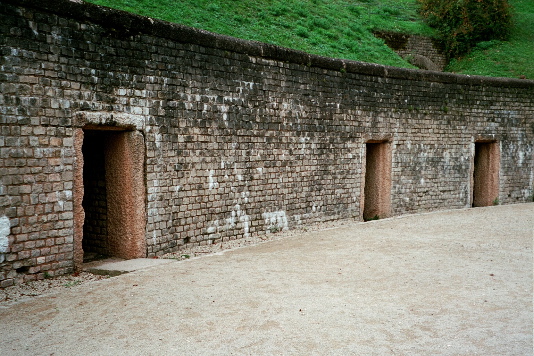| Course Home |
|
Syllabus |
| Handouts |
| Lecture Notes |
| Resources |
| Old Announcements |
|
|
<<
Back |
|
 |
| ... and the
weapons and the warriors to defend
it. |
 |
| Armor from
the middle ages at Wolfsegg
castle. |
 |
|
|
| A wall can
be massive and built for defense. |
 |
| But strong
walls can be breached. |
 |
| Ruined
castle, Preunschen, Germany |
 |
|
|
| ...and
finally stand only as ruins. |
 |
| Roman
ruins, Trier, Germany |
 |
| Beware of
doors hiding lions! |
 |
| Roman
Arena, Trier, Germany |
|
|
| Ruins of
Great Wall, China |
 |
| Guard
tower. |
 |
| Port for
firing arrows. |
 |
| Earth's
largest man-made structure. |
|
|
1 Official Yale course
listing:
[CPSC
467]
2 Course Description
As the title suggests, this course is about
cryptography and computer security. Perhaps a more apt
title would be "Cryptography and Information Security."
Cryptography, because it is a fascinating field of study
that is also a key technology for achieving security
objectives, and security because of its central
importance to our emerging "information society."
Security policies will shape the kind of society we live
in, and cryptography will have a major impact on the
kinds of security policies that are achievable.
Information security, broadly defined, involves
controlling the dissemination of information. It includes
issues of privacy, data integrity, authenticity, and
authority. Privacy refers to preventing information flow
to unintended recipients. Data integrity properties
insure that information is correct and undamaged.
Authenticity identifies information with a source.
Authority describes what actions are permitted by whom.
Because of the ease with which information can be copied
and transmitted, traditional physical means of control
are of limited efficacy. Cryptography gives a way to
build logical controls on the flow of information that
are largely independent of the physical properties of the
devices used to transmit and store information.
Cryptography lies at the center of this course, but
we will be approaching the subject broadly. On the one
end, we'll look at problems of information security and
see how cryptographic tools can be used to solve them.
We'll also touch on some social issues surrounding the
use of cryptography. At the other end, we'll explore the
mathematical structures from which cryptographic
primitives are built.
Security properties cannot be verified through
testing since there is no way to test all possible
attacks. Instead, they must be verified analytically
through security modeling. This means establishing
mathematical models in which security properties can be
formally stated and proved.
This course will spend roughly equal time on
security protocols, cryptographic primitives, and
cryptographic modeling. Rather than attempt to study each
of these topics separately, we will look at a number of
natural and well-motivated security problems and discuss
each in depth. In the process we will introduce the
cryptographic primitives and develop the mathematical
tools needed to analyze them.
In greater detail, we will be looking at the
following topics, as time permits:
-
Security problems and systems. Privacy and
security in the information age. Multiparty problems:
Secret message transmission, authentication, key
distribution, key escrow, digital signatures,
certified mail, contract-signing, coin flipping, and
so forth. Practical systems: Kerberos, SSH, PGP,
smart cards, SSL.
-
Cryptographic primitives and specific
realizations. Primitives: Transposition and
substitution ciphers, private and public key
encryption systems, digital signatures, message
digests, key exchange, secret sharing, pseudorandom
number generation. Realizations: AES, DES, RSA, RC6,
DSA, SHA, MD5.
-
Mathematics for cryptography. Information
theory. Number theory: Prime numbers and factoring,
modular arithmetic, computations in finite fields,
discrete logarithms. Complexity theory. Theory of
distributed systems.
3 Course materials
Required textbook: Wade Trappe
and Lawrence C. Washington,
Introduction to Cryptography with Coding
Theory, Second Edition, Pearson Prentice Hall,
2006, ISBN 0-13-186239-1.
Website:
I maintain a course website at http://zoo.cs.yale.edu/classes/cs467/2005f/index.html.
You should bookmark it in your browser and visit it
often. It will grow as the term progresses and will
contain announcements, handouts, lecture notes, revisions
to homework assignments, programming hints, and links to
documents in the course directory and elsewhere on the
web. Access is restricted to machines on the Yale
network. For off-campus use, you will need to follow
the instructions for use of the
Yale remote authentication proxy server.
4 Course Mechanics
Prerequisites: This course will
be taught at an advanced undergraduate/graduate level and
assumes a basic computer science background. Some C
programming will be required. CPSC 202a and 223b are
prerequisites. Graduate students should have an
equivalent background.
Requirements: Course
requirements include written problem sets and programming
assignments ( ∼ 30%), a midterm exam
( ∼ 25%), and a final exam
( ∼ 45%). The approximate weights of each
in determining the course grade are shown following in
parentheses. Graduate students taking the course will be
expected to perform at a higher level than undergraduates
and may be required to do additional work.
Assignments and other
announcements: Written problem sets and
programming assignments will posted on the
handouts page of the course website from time to time
during the course. Other course announcements will be
posted on the course home page.
It is your responsibility to check these pages
frequently.
Email: I am always available for
email consultation at fischer-michael@cs.yale.edu.
I can't always promise to respond right away, but I
can often be reached by email when I am away from the
office. Email is also the preferred way to arrange an
appointment with me.
5 Policies
Late Policy: Late work will be
accepted at the discretion of the instructor and/or TA
and will generally be subject to a penalty unless
accompanied by a Dean's excuse. Work will not be accepted
after graded papers have been returned or solutions
released. However, alternative means for making up missed
work may be arranged on an individual basis with a Dean's
excuse.
Please contact the instructor or TA as soon as
you find out that you are unable to submit work on time
or to attend a scheduled exam so that suitable makeup
arrangements can be made.
Policy on Working Together: Work
turned in under your name must be your own work.
Plagiarism is unethical and will not be tolerated. You
may neither copy from others nor permit your own work to
be copied. Therefore, it is important that you keep your
files protected so that others cannot read them and that
you carefully guard your password. If you think your
password may have been compromised, you should change it
immediately.
You may of course discuss the lectures and readings
with your classmates in order to improve your
understanding of the subject. However, all written work
must be your own. You are also always free (and
encouraged) to come in and ask the TA or instructor for
help about anything concerning the course. Please talk to
me if you have any questions about this policy.
Policy on Computer Problems: The
Yale College policy on "Use of Computers and Postponement
of Work" in the Yale College Programs of Study applies to
this course. It is reproduced below.
"Problems that may arise from the use of computers,
software, and printers normally are not considered
legitimate reasons for the postponement of work. A
student who uses computers is responsible for operating
them properly and completing work on time. (It is
expected that a student will exercise reasonable
prudence to safeguard materials, including saving data
on removable disks at frequent intervals and making
duplicate copies of work files.) Any computer work
should be completed well in advance of the deadline in
order to avoid last-minute technical problems as well
as delays caused by heavy demand on shared computer
resources in Yale College."
Particularly relevant for this course are
the cautions against leaving a programming assignment to
the last minute when machines might be busy, printers
broken, and so forth, and about safeguarding your data.
6 Computing
Facilities
The Zoo: This course will be
using the Computer Science Department's educational
computing facility, otherwise known as the Zoo. This facility contains
Pentium-based PC's running Linux. You will need to learn
how to use these machines if you don't already know how
in order to read email, browse course-related web pages,
edit and compile C programs, and access the course
directory. Look at
http://zoo.cs.yale.edu/help/
for information on getting started if you
are new to the Zoo.
Your course account: You should
request a course account for this course even if you
already have a Zoo account, for otherwise you will
be unable to submit work electronically. To obtain your
account, go to
http://zoo.cs.yale.edu/help/accessing-zoo.shtml
and follow the instructions there.
Course directory: The shared
course directory, /c/cs467, is located on the
Zoo server. You can access it from your Zoo course
account. It will contain software that you will be using
for this course and miscellaneous documentation and
files. It will also contain the software that you will
use when submitting assignments electronically. Public
files there can be accessed via the web as well as from a
Zoo node. Your class account home directories will also
be located there.
File translated from TEX by TTH, version 3.66.
On 31 Aug 2005, 13:44.
|
